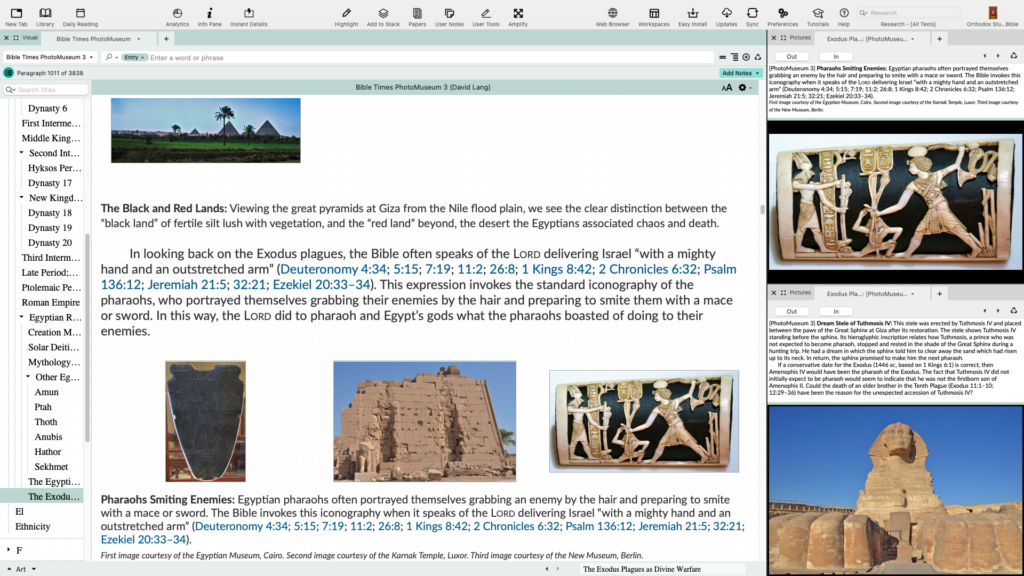I admit it: when I was working on the original PhotoMuseum, I procrastinated writing articles about Egypt. I had several reasons for wanting to avoid it as long as I could.

To begin with, there was just so much to cover. Ancient Egypt from its beginnings through the Roman period amounts to some 3500 years of history. That’s a lot of pharaohs, temples, battles, and inscriptions. Speaking of a lot, do you have any idea how many gods the Egyptians worshiped? It’s absolutely bewildering.
Then there was the challenge of sorting out what I was looking at with the thousands of photos available to me. Oh look! Here’s another pharaoh grabbing his enemies by the hair and getting ready to club them to death. But which pharaoh is it? How in the world can I tell? Sorting all that out just seemed like a bottomless pit.
But the main reason I procrastinated adding Egypt to the PhotoMuseum was that it didn’t interest me all that much. Study the Assyrians and Babylonians and you see intersections with a great deal of biblical history, but study the Egyptians and what does that shed light on? A few episodes in Genesis and the first half of Exodus? Think about it. Most of biblical history was contemporaneous with the Third Intermediate Period, well after Egypt’s heyday. So was it really that important to cover the pyramids?
Eventually, I bit the bullet and wrote a couple of general articles about the Egyptians, simply because Egypt was too important to ignore completely. To my surprise, I suddenly began seeing how much learning about Egypt was helping me better understand the Bible. The more I discovered points of comparison between the Bible and the culture of ancient Egypt, the more interested in Egypt I became. It wasn’t long before I became consumed with learning all I could about ancient Egypt, reading anything I could get my hands on, making my family watch documentary after documentary, even taking a course on reading Egyptian hieroglyphs. I began to see why so many European aristocrats developed a kind of mania for ancient Egypt during the halcyon days of Egyptian archaeology. Like so many of them, I have become a serious Egyptophile. Sadly, I never had the money or connections to buy an obelisk and have it set up on my front lawn!
What I did have was a wealth of photographs to examine and decipher. And I was right about it being a bit of a bottomless pit. There is just so much history to discover, so many monuments and inscriptions left behind, and best of all, so many interesting connections to Scripture. As fun as learning about Egypt became for me, I didn’t watch all those documentaries or learn to read hieroglyphs just for fun. I wanted to understand as much as possible to help Accordance users better comprehend the world of the Bible.
We’ve just released the third edition of the PhotoMuseum. Existing articles about Egyptian history and burial practices have been greatly expanded, and where the second edition added articles about the most biblically relevant pharaohs, PhotoMuseum 3 now covers most major pharaohs as well as many minor ones. There’s also a massive new article on Egyptian religion, which covers Egyptian creation myths (there are several), solar deities (there are several), the Osiris cycle of myths, concepts of the soul (there are several), and other important deities (there are…well, you get the idea!).
My favorite new article on Egypt is entitled, “The Exodus Plagues as Divine Warfare.” Preachers often portray the plagues as aimed at humiliating specific gods in the Egyptian pantheon, but most attempts to match particular deities with a given plague amount to eisegesis rather than exegesis. In that article, I present a far better way to conceive of the plagues as divine warfare—one I think really enriches our understanding of the exodus.
PhotoMuseum 3 article on The Plagues as Divine Warfare
The more I have learned about ancient Egypt in all its color and complexity, the more I have become a late-blooming Egyptophile. How can you help but be impressed with a civilization that retained its cultural identity for thousands of years and became the standard most other ancient peoples tried to emulate? Falling under Egypt’s spell has taught me to appreciate all the more the ancient Hebrews’ remarkable resistance to it. For hundreds of years they lived in the heart of this spectacular civilization, yet remained (mostly) faithful to the God of their fathers. That’s a legacy that is pretty difficult to ignore, and an inspiration to anyone who feels like “a stranger in a strange land” (Exodus 2:22).
If you too would like to become a late-blooming Egyptophile, be sure to purchase (or upgrade to) the new Accordance Bible Lands PhotoMuseum 3 today.


